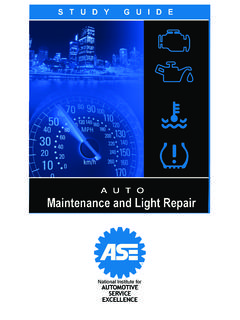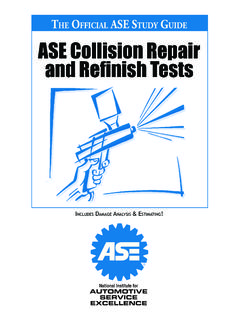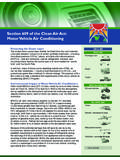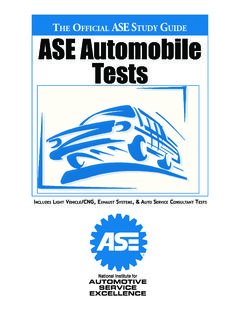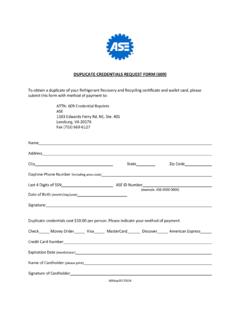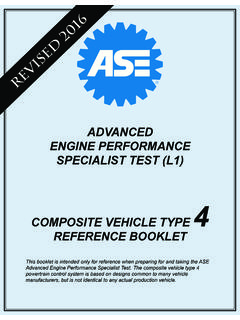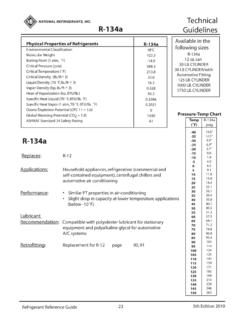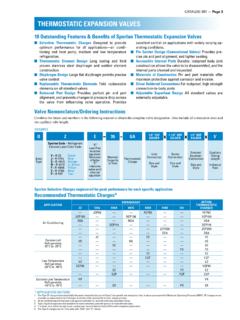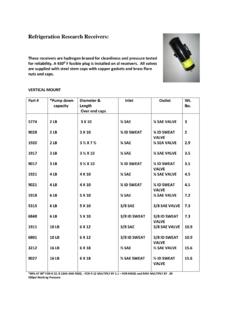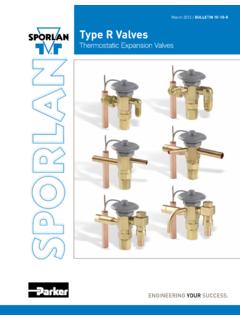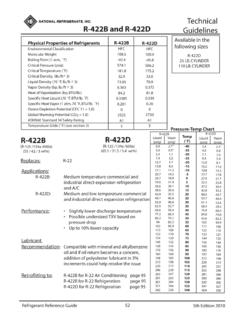Transcription of Refrigerant Recovery and Recycling - ASE
1 Refrigerant Recovery and RecyclingREVIEW AND QUIZEPA-Approved Section 609 Program for Motor Vehicle Air Conditioning (MVAC) ServiceNow with R-1234yfThis booklet is distributed free of charge and is not to be Mar. 2017 Table of ContentsThe Next Generation of Air Conditioning Service ..3 Terms and Acronyms .. 4 Refrigerants and Their Impact on Health and the Environment .. 5R-12 From Miracle to Menace ..5 Risks and Effects of Excess UV Ozone Depletion to Global Warming ..6 Environmental Impact of MVAC Refrigerants ..6 EPA Regulations .. 8 Section 609 of the Clean Air Act Amendments of 1990.
2 8 Section - Prohibitions and required practices ..8 Section - Approved Refrigerant handling equipment ..8 Section - Certification, recordkeeping and public notification requirements ..10 Section 608 Programs - Differences and Overlap ..10 Venting Prohibited ..10 Alternative Refrigerants ..11 Refrigerant Sales Restriction ..11 SNAP Overview ..11 Final SNAP Rule ..11 Acceptable Substitutes in MVAC ..12 Unacceptable Substitutes ..13 Retrofitting ..14 MVAC System Hoses ..14 Refrigerant Fitting Sizes ..15 Caution with Flammable Refrigerants, Including Hydrocarbon Refrigerants.
3 15 Next Generation Air Conditioning Systems ..15 Responsible Refrigerant Management ..17 Safety First ..17 Recovery / Recycling /Recharge Equipment ..17 Best Practices for Working with Refrigerant Systems ..18 Used R-134a Refrigerant from Non-Mobile Recycled R-12 and R-134a Stored in Portable Containers ..19 How to Recover Refrigerant on R-12 and R-134a Systems ..20 Portable Container Pressure Charts ..21 Service Hoses ..22R-1234yf Systems and R-744 Systems ..22 Key R-744 Safety Points from J2845 ..23 Refrigerant Identification and Preventing Cross-Contamination ..23 Leaks and Leak Locating and Repairing MVAC Refrigerant Leaks.
4 25 Refrigerant Cylinder Identification and Fitting Size ..27 Refrigerant Charging ..27 System Charge Calculations ..28 Copyright 2017 National Institute for Automotive Service ExcellenceRefrigerant Recovery and Recycling : Review and Quiz 3 The Next Generation of Air Conditioning Service We ve come a long way since the discovery of the infamous ozone hole over Antarctica. Due in part to your valiant efforts as a service technician, NASA now forecasts that the ozone layer will likely return to its early 1980s status around 2065.
5 It s a big step in the right direction. Unfortunately, all this progress comes with a side-effect. With roughly two decades of R-134a serving as R-12 s successor, we ve learned that R-134a poses its own threat as a greenhouse gas. With environmental emphasis now changing, we re at the forefront of another Refrigerant transition. Initially, it appeared that R-1234yf would become the Refrigerant heir-apparent to R-134a, due to R-1234yf s low global warming potential (GWP). Then, other alternatives appeared on the Refrigerant landscape such as R-744 (CO2) and R-152a, along with regulatory initiatives from both the and the European Union.
6 This global combination of regulations, along with continued research on alternative refrigerants, presents the possibility of multiple alternatives to R-134a when all is said and done. Refrigerants aside, air conditioning systems themselves are going through an unprecedented transformation. What was once a simple creature comfort for upscale motorists, air conditioning systems of today are true thermal management systems, providing not only occupant comfort, but also providing essential cooling to battery packs and onboard computers in hybrid vehicles. It s also possible that other A/C system designs may enter the marketplace, such as secondary-loop systems, so stay on top of the latest developments.
7 All this uncertainty has also created the perfect breeding ground for counterfeit refrigerants. Rogue Refrigerant blends have surfaced in the industry, often convincingly packaged as pirated versions of those from reliable brands and suppliers. Be vigilant with all refrigerants that enter your shop by using a Refrigerant identifier. It s your best defense. See the information in this training material for details on Refrigerant identification. The world of alternative refrigerants is changing rapidly, so it s wise to keep a close eye on industry journals for news of other alternatives that may be listed as acceptable, under certain use conditions, by the EPA under its Significant New Alternatives Policy (SNAP).
8 Also, be sure to check state and local regulations as they may differ from federal requirements. Make a commitment to yourself and your customers to stay informed on any news affecting the world of air conditioning service. Just drop by the ASE website at for major developments. You can access information from the EPA on motor vehicle air conditioning on the web at for being part of the next generation of air conditioning A. ZilkePresident, ASET imothy A. ZilkePresident, ASE4 Refrigerant Recovery and Recycling : Review and QuizTerms and Acronyms Used In This Training MaterialClass I SubstanceOzone-depleting chemical with an ozone-depletion potential greater than ( CFCs)Class II SubstanceOzone-depleting chemical with an ozone-depletion potential less than ( HCFCs)CFCsChlorofluorocarbons such as CFC-12 (R-12)HCFCsHydrochlorofluorocarbons such as HCFC-22 (R-22)HFCsHydrofluorocarbons such as HFC-134a (R-134a)HFOsHydrofluoroolefins such as HFO-1234yf (R-1234yf)
9 MVACM otor Vehicle Air ConditioningMVAC-like applianceA system used on a vehicle substantially identical to an MVAC. This type of system uses a mechanical vapor compression, open-drive compressor to cool the driver s or passenger s compartment of a non-road vehicle, including agricultural and construction substanceNote: The ASE Refrigerant Recovery and Recycling Review and Quiz is an EPA-approved program that meets Section 609 regulations as set forth in Section 609 of the Clean Air Act Amendments of 1990. This program is intended only for technicians servicing MVACs and MVAC-like appliances.
10 Under no circumstances should this program be considered as acceptable for Section 608 compliance, a separate requirement that applies to the servicing of stationary refrigeration and air conditioning systems, such as those used in commercial and residential applications. Furthermore, some state and local jurisdictions have adopted their own requirements for credentials, so check with your state and local authorities for details. Certification earned as a result of a passing score on the enclosed quiz is only deemed as certification in the context of the EPA. This credential is not the equivalent of technical certification from the main ASE testing and certification program.
